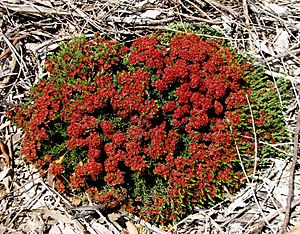Mouse featherflower facts for kids
Quick facts for kids Mouse featherflower |
|
|---|---|
 |
|
| Verticordia fastigiata in the Royal Botanic Gardens, Cranbourne | |
| Scientific classification | |
| Genus: |
Verticordia
|
| Species: |
fastigiata
|
| Synonyms | |
|
Verticordia conferta Benth. |
|
The Verticordia fastigiata, also known as the mouse featherflower, is a beautiful flowering plant. It belongs to the Myrtaceae family, which is the same family as myrtle trees. This plant grows naturally only in the south-west part of Western Australia.
The mouse featherflower is a low-growing shrub. It has small leaves shaped like clubs. Its flowers have a unique scent, a bit like a mouse! These flowers can be many colors, from golden-yellow and orange to a deep dark red.
Contents
What it Looks Like
The mouse featherflower is a small shrub. It usually grows to be about 20 to 40 centimeters (8 to 16 inches) tall. It can spread out to be 10 to 60 centimeters (4 to 24 inches) wide. It has one main stem that branches out a lot.
Its leaves are shaped like small clubs. They are almost round if you cut them across. Each leaf is about 2 to 5 millimeters (0.08 to 0.2 inches) long and has a rounded tip.
The flowers of this plant smell like a mouse. They grow in groups that look a bit like a flat-topped cluster. Each flower sits on a tiny stalk, about 1 to 2 millimeters (0.04 to 0.08 inches) long. The flowers can be lemon-yellow and red, golden-yellow and orange, bronze, or even deep red.
The base of the flower, called the floral cup, is shaped like a wide top. It's about 0.8 millimeters (0.03 inches) long and feels a bit hairy. The sepals, which are like small leaves protecting the flower bud, are yellow to dark red. They are about 1.7 millimeters (0.07 inches) long and have four fuzzy tips. The petals are about 1 millimeter (0.04 inches) long. They are broad and egg-shaped with tiny jagged edges. They can be shiny yellow to dark red. The style, which is part of the flower's reproductive system, is 4 to 5.5 millimeters (0.16 to 0.22 inches) long. It can be straight or slightly curved and has a few short hairs. You can see these flowers blooming from January to July.
How it Got its Name
The Verticordia fastigiata was first officially described in 1852. A Russian botanist named Nikolai Turczaninow gave it its scientific name. He based his description on plants collected by another botanist, James Drummond. The description was published in a scientific bulletin in Saint Petersburg.
The second part of its scientific name, fastigiata, comes from a Latin word. It means "having parallel, upright branches." This describes how the plant tends to grow.
Another plant, Verticordia conferta, was described in 1871. However, scientists later realized it was the same species as Verticordia fastigiata. So, Verticordia conferta is now considered a synonym (another name) for Verticordia fastigiata.
In 1991, a botanist named Alex George studied the whole Verticordia group of plants. He placed Verticordia fastigiata into a smaller group called Micrantha. Other plants in this group include V. minutiflora and V. vicinella.
Where it Lives
This type of verticordia plant grows in sandy loam and clay soils. These soils are often found over sandstone rock. Sometimes, it grows alongside other verticordia species in low, open areas called heathlands.
You can find the mouse featherflower in the southern parts of Western Australia. It grows in areas between Ongerup and Cape Riche. These areas are known as the Esperance Plains, Jarrah Forest, and Mallee regions.
Conservation Status
The Western Australian Government's Department of Parks and Wildlife has looked at the Verticordia fastigiata. They have classified it as "not threatened." This means the plant is not currently in danger of disappearing.
How People Use it
People often grow this verticordia plant in gardens. It's usually grown from cuttings, which are small pieces of the plant that can grow into a new plant. These cuttings usually start to grow roots easily. However, it takes a while for the new plants to get strong once they are planted in the ground. It might even take several years for them to produce flowers.
The mouse featherflower grows well in Western Australia. It also does well on the east coast of Australia if it's planted in light soils and a sunny spot. Once the plants are established, they can handle moderate frost. They are also pretty good at resisting pests that might try to eat them.

